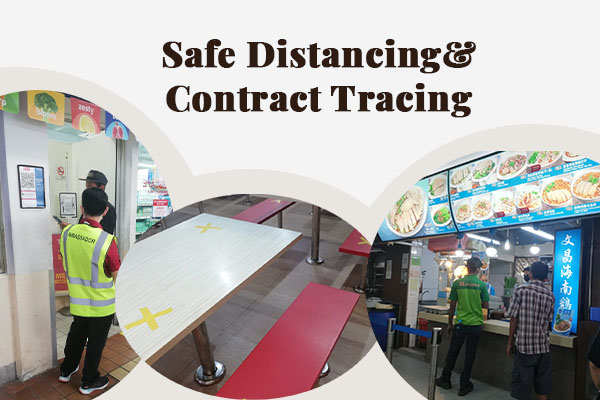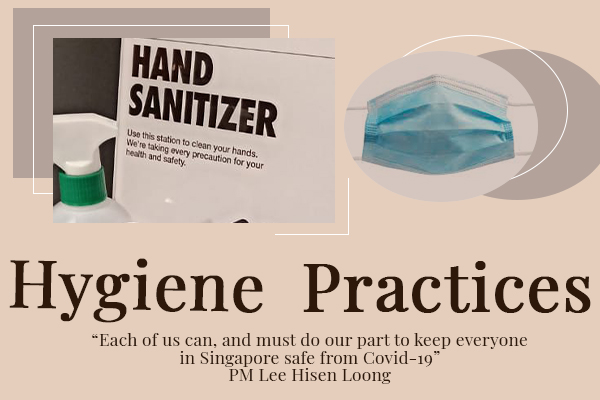Life in Phase 2 of Circuit Breaker for essential workers
Post Date: 13 Oct 2020
By Lim Lek Suen, Seah HuiLan & Nicole Ang
When the circuit breaker (CB) was announced by the Singapore government on April 3, the movements of most Singaporeans were restricted, save for essential services workers. Doctors, nurses, cleaners, hawkers, garbage collectors - these were some of the people who were considered essential to our society.
When phase two of the CB started on June 19, it represented another set of changes that Singaporeans had to get used to. While most cheered at the easing of guidelines, these essential workers had to prepare for a new norm in their daily routines.
1. Safe distancing in shops/ contact tracing
 (PHOTO: Seah HuiLan) Photo of safe distancing, scanning of QR codes and tapes on tables and chairs. Photo taken and edited on June 6, 2020.
(PHOTO: Seah HuiLan) Photo of safe distancing, scanning of QR codes and tapes on tables and chairs. Photo taken and edited on June 6, 2020.
One highlight of phase two was the resumption of dining in for food and beverage (F&B) outlets. To F&B workers, however, it meant that they had to take extra steps to ensure that they remain compliant with the guidelines set out by the Ministry of Health. For instance, they had to space out customers who were queuing or sitting at the tables, and also ensure that they do not reach capacity limits.
“We have to wear masks all the time,” said Brian Soh, 18, a part-time kitchen staff at Bonchon Chicken. “We also have to refry the chicken as long as it’s been there for five minutes.”
Some of Brian’s duties include the preparation of food and the calling of orders.
“Personally, I prefer business before phase two as it was more efficient then,” he shared. “With all the safety measures in place, business is slowed down and we have a lesser number of customers.”
2. Alternate shifts
 (PHOTO: Nicole Ang) Photo of hand sanitisers in store and nurses wearing masks. Photo taken and edited on
(PHOTO: Nicole Ang) Photo of hand sanitisers in store and nurses wearing masks. Photo taken and edited on
Despite the number of community COVID-19 cases decreasing, the government is gradually reopening the economy. According to TODAY, Education Minister Lawrence Wong, who also co-chairs the governmental task force that is tackling COVID-19, said that the government is “still doing things in a calibrated and controlled manner”.
Currently, the guidelines for phase two have resulted in additional responsibilities, such as practising good personal hygiene, for most workers in sectors such as retail and F&B. Employers have to follow these strict guidelines to ensure the safety of their workers as well. Essential staff are required to keep a distance of at least, one metre apart from each of their work stations. As a result, most stores have changed their rosters to include fewer staff to minimise contact.
“It is a dampener on morale as I was not able to meet my colleagues as some are taking turns working at home and alternating shifts,” explained Zachary Chua, 29, a human resource professional, who manages 600 staff at the Changi General Hospital.
When asked about the differences between working in phases one and two of the CB, Zachary shared: “Working through the circuit breaker period was actually rather calming, to be honest. Once you get used to how quiet and perhaps eerily desolate it can be, it’s very relaxing to be out without the crowds and heavy traffic”.
3. Business safety measures
 (PHOTO: Nicole Ang) Photo of empty shops/closed stores (before circuit breaker) and long queues at outlets (after circuit breaker
(PHOTO: Nicole Ang) Photo of empty shops/closed stores (before circuit breaker) and long queues at outlets (after circuit breaker
The mandate to stay at home as much as possible during this pandemic led to a double-edged outcome: the rise in online shopping.
Things such as medical supplies and indoor exercise equipment have become sought after items on e-commerce platforms. Through the use of food delivery apps like FoodPanda, Grabfood and Deliveroo, people have also turned to online platforms to purchase their daily meals and to satisfy their cravings. Even with the reopening of Singapore’s economy after circuit breaker, experts predict that e-commerce would still be on the rise.
Unsurprisingly, the demand for medical equipment such as thermometers and personal protection equipment also increased exponentially.
“The increase in demand has definitely expanded my job scope and responsibilities,” said Stephanie Ang, 38, who works in the air freight logistics industry, handling the import and export of several medical supplies. “This is not just a local need, but also a need in the international (community).”
When the phase two commenced, many Singaporeans were over the moon about having to go outside to dine-in at eating places.
However Stephanie was wary, being in favour of phase one being prolonged.
“It’s a (larger) risk now,” she said. “With phase two, my chances of getting infected are higher.”


